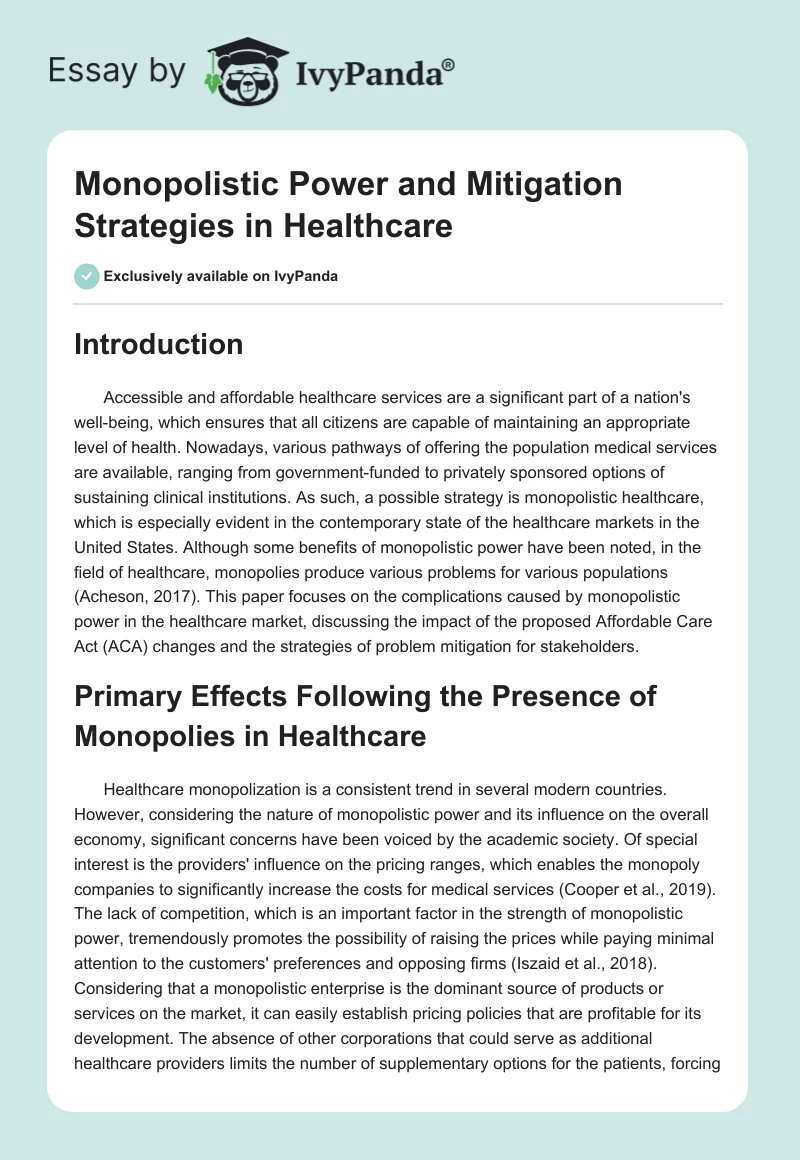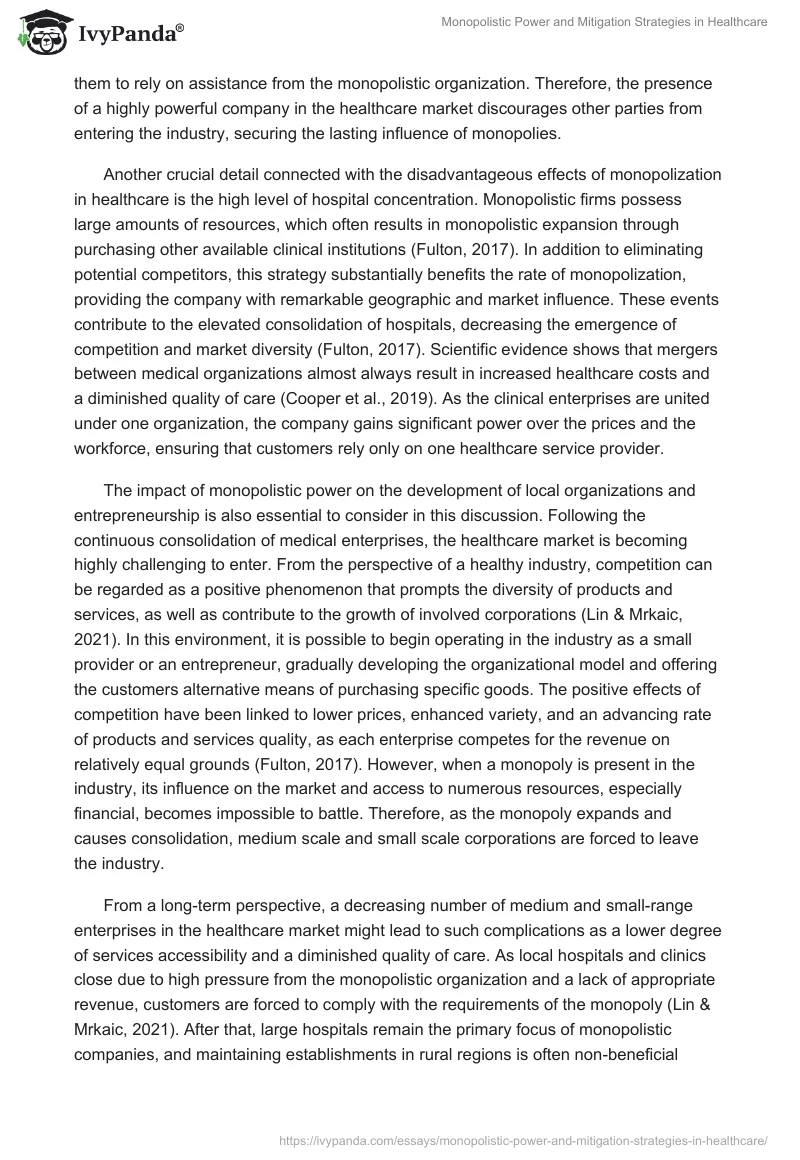Introduction
Accessible and affordable healthcare services are a significant part of a nation’s well-being, which ensures that all citizens are capable of maintaining an appropriate level of health. Nowadays, various pathways of offering the population medical services are available, ranging from government-funded to privately sponsored options of sustaining clinical institutions. As such, a possible strategy is monopolistic healthcare, which is especially evident in the contemporary state of the healthcare markets in the United States. Although some benefits of monopolistic power have been noted, in the field of healthcare, monopolies produce various problems for various populations (Acheson, 2017). This paper focuses on the complications caused by monopolistic power in the healthcare market, discussing the impact of the proposed Affordable Care Act (ACA) changes and the strategies of problem mitigation for stakeholders.
Primary Effects Following the Presence of Monopolies in Healthcare
Healthcare monopolization is a consistent trend in several modern countries. However, considering the nature of monopolistic power and its influence on the overall economy, significant concerns have been voiced by the academic society. Of special interest is the providers’ influence on the pricing ranges, which enables the monopoly companies to significantly increase the costs for medical services (Cooper et al., 2019). The lack of competition, which is an important factor in the strength of monopolistic power, tremendously promotes the possibility of raising the prices while paying minimal attention to the customers’ preferences and opposing firms (Iszaid et al., 2018). Considering that a monopolistic enterprise is the dominant source of products or services on the market, it can easily establish pricing policies that are profitable for its development. The absence of other corporations that could serve as additional healthcare providers limits the number of supplementary options for the patients, forcing them to rely on assistance from the monopolistic organization. Therefore, the presence of a highly powerful company in the healthcare market discourages other parties from entering the industry, securing the lasting influence of monopolies.
Another crucial detail connected with the disadvantageous effects of monopolization in healthcare is the high level of hospital concentration. Monopolistic firms possess large amounts of resources, which often results in monopolistic expansion through purchasing other available clinical institutions (Fulton, 2017). In addition to eliminating potential competitors, this strategy substantially benefits the rate of monopolization, providing the company with remarkable geographic and market influence. These events contribute to the elevated consolidation of hospitals, decreasing the emergence of competition and market diversity (Fulton, 2017). Scientific evidence shows that mergers between medical organizations almost always result in increased healthcare costs and a diminished quality of care (Cooper et al., 2019). As the clinical enterprises are united under one organization, the company gains significant power over the prices and the workforce, ensuring that customers rely only on one healthcare service provider.
The impact of monopolistic power on the development of local organizations and entrepreneurship is also essential to consider in this discussion. Following the continuous consolidation of medical enterprises, the healthcare market is becoming highly challenging to enter. From the perspective of a healthy industry, competition can be regarded as a positive phenomenon that prompts the diversity of products and services, as well as contribute to the growth of involved corporations (Lin & Mrkaic, 2021). In this environment, it is possible to begin operating in the industry as a small provider or an entrepreneur, gradually developing the organizational model and offering the customers alternative means of purchasing specific goods. The positive effects of competition have been linked to lower prices, enhanced variety, and an advancing rate of products and services quality, as each enterprise competes for the revenue on relatively equal grounds (Fulton, 2017). However, when a monopoly is present in the industry, its influence on the market and access to numerous resources, especially financial, becomes impossible to battle. Therefore, as the monopoly expands and causes consolidation, medium scale and small scale corporations are forced to leave the industry.
From a long-term perspective, a decreasing number of medium and small-range enterprises in the healthcare market might lead to such complications as a lower degree of services accessibility and a diminished quality of care. As local hospitals and clinics close due to high pressure from the monopolistic organization and a lack of appropriate revenue, customers are forced to comply with the requirements of the monopoly (Lin & Mrkaic, 2021). After that, large hospitals remain the primary focus of monopolistic companies, and maintaining establishments in rural regions is often non-beneficial under such circumstances. Furthermore, quality of care is a major factor affected by hospital merging and consolidation, as monopolistic chains require a large number of resources to sustain their power on the market (Lin & Mrkaic, 2021). Altogether, the monopolization tendency is a significant complication for healthy competition and subsequent market growth, causing difficulties in high price mitigation and the provision of adequate customer service.
New Changes in the Affordable Healthcare Act and the Power of Monopolistic Providers
On June 28, 2021, the Centers for Medicare and Medicaid Services introduced several changes to the ACA. Although the overall goal of the adjustments is to modernize the market and provide the shareholders with more extensive access to healthcare services, issuing these changes might negatively impact the competition and diversity aspects of the healthcare industry. As such, the user fee for clinical services has been raised significantly, resulting in approximately a $200 million increase in user payments (Health Affairs, 2021). Therefore, entry into the ACA program becomes more difficult for the general population, requiring higher expenses and limiting the options available to the consumers (Lin & Mrkaic, 2021). Considering this evidence, the proposed rule further enhances the power held by the monopolistic healthcare providers involved in the provision of medical services under the ACA.
Another crucial alteration refers to the exchange direct enrollment possibility. This pathway was included in the January adjustment and promoted the states to transition from a centralized government entity towards private insurers and healthcare providers (Health Affairs, 2021). However, the newest changes eliminate this option and force the states to rely on the monopolistic healthcare companies suggested by the ACA, which subsequently advances the monopolies’ power over the market (Acheson, 2017). In this regard, the regulatory mechanisms that should be provided by the government to counteract the negative consequences of monopolistic influence are still absent from this legislation.
Opposing Monopolistic Healthcare: Strategies for the Government and Shareholders
Considering the discussed ramifications that prevent the functioning of effective healthcare industry and impede the development of medical services quality, appropriate methods to address these complications are required. Scholars have proposed several tactics that could negate the effects of monopolistic power on the healthcare market, providing additional options for the involved parties, namely other clinical businesses, government entities, and the consumers (Fulton, 2017). One of the potential approaches relies on the discouragement of hospital mergers, which leads to consolidation and enhances the strength of the local monopolies. Preventing hospital concentration and encouraging competition would be especially valuable for future medical organizations and clients, allowing them to participate in the industry without extreme expenses (Fulton, 2017). As such, federal grants and any willing provider laws are considered prominent strategies that could address these requirements.
After that, price transformation and regulation are highly vital for appropriately managing the healthcare sector. It is proposed that federal and state laws that prohibit the monopolies from significantly raising medical services costs code positively influence the market, mitigating the monopolies’ control over the pricing ranges (Roy, 2020). Public disclosure of pay provider contracts might be a viable possibility that eliminates the occurrence of anticompetitive practices and supports healthy competition. In addition, reference pricing might also contribute to the establishment of lower costs and higher service quality by prompting the hospitals to maintain their prices under a specific value (Roy, 2020). Although the long-lasting effects of monopolistic power on the healthcare sector might be challenging to negate, these methods allow hindering the monopoly is progression and ensure the development of a healthy market environment.
Conclusion
To conclude, the complications following the presence of monopolistic power in the healthcare sector have been discussed in detail in this paper, highlighting the increased costs, hospital concentration, low market diversity, and a decreased quality of medical services as the primary disadvantages. It is evident that monopolistic organizations negatively affect the welfare of various involved entities, from other potential competitors to government entities and customers. As such, monopolies force the shareholders to follow policies established by the dominant corporation, which results in tremendously expensive healthcare services, diminished standards of care, and lowered accessibility. Furthermore, monopolistic power obstructs the development of healthy competition, which detrimentally influences market growth. The proposed changes to the ACA have been highlighted as obstructive to future healthcare development, enabling monopolistic enterprises to usurp their power. Such strategies as price mitigation, prevention of hospital mergers, and reference prices might be advantages for addressing these issues, ensuring that healthcare remains accessible and affordable for the citizens.
References
Acheson, K. R. (2017). Rural healthcare facilities: Monopolies to cooperatives. Archives of Chemistry and Chemical Engineering, 1(1). Web.
Health Affairs. (2021). Biden administration’s first marketplace rule promotes coverage and reverses Trump-Era changes. Web.
Cooper, Z., Craig, S. V., Gaynor, M., & Van Reenen, J. (2019). The price ain’t right? Hospital prices and health spending on the privately insured. The Quarterly Journal of Economics, 134(1), 51–107. Web.
Fulton, B. D. (2017). Health care market concentration trends in the United States: Evidence and policy responses. Health Affairs, 36(9), 1530–1538. Web.
Lin, L., & Mrkaic, M. (2021). U.S. healthcare: A story of rising market power, barriers to entry, and supply constraints. IMF Working Papers, 2021(180). Web.
Iszaid, I., Hafizan, A., & Muhamad, H. J. (2018). Market failure in health care: A review. International Journal of Public Health and Clinical Sciences, 5(5), 16–25. Web.
Roy, A. (2020). Improving hospital competition: A key to affordable health care. Web.


